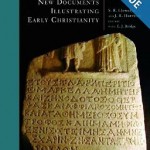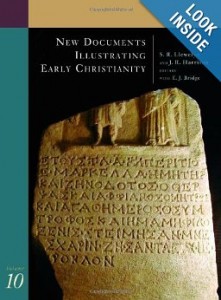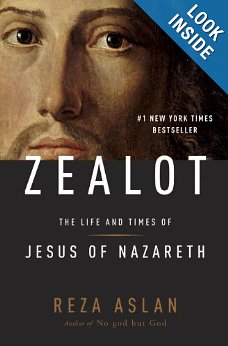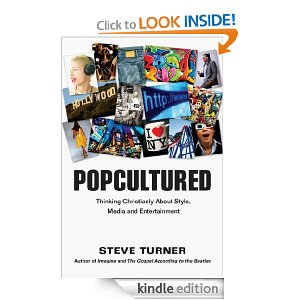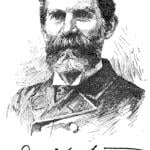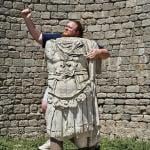
Here is the lecture I gave May 2nd at Castle College on the Bible and the Media…
RELIGION AND THE MEDIA IN THE POST-MODERN WORLD
PROLEGOMENA
I have spent a great deal of my time as a professor of Biblical Studies working with the media— ABC, NBC, CBS, the BBC, the Discovery and History Channels and so on. There are really two different sorts of dealings with the media that people who teach religion or theology are likely to have in this day and age— questions from the press about recent archaeological discoveries or developments in the Lands of the Bible, and secondly Christmas and Easter or even other sorts of specials commissioned by some major network as a program or series of programs. For an example of the latter, take the BBC series I did called the Story of Jesus, which aired here and in the U.S. a couple of Easter seasons ago. Usually what happens is that the print media news division gives tips to the program division about who to interview and who speaks well on camera and then you get a phone call. Print media interviews are of a more urgent nature (‘can I speak to you today…’) because of something suddenly being newsworthy, whereas TV programs gestate over a longer period of time. Now a days, much is created in a sound studio with the help of CG, but there are still series, such as the Story of Jesus, or the show I did for CBS called The Mystery of Christmas, where you go and film in Israel or elsewhere on location.
None of this might seem very important to you in the classroom, except as the occasional film clip to be used to illustrate your teaching about religion or the Bible, except that unfortunately in a post-modern, and increasingly post-Western, post-Christian era, even in large parts of the West itself, there is rampant Biblical illiteracy even among the well educated, and that includes the media. In this sort of situation, perception is reality and image is crucial. In other words, one of the reasons you find yourself having to justify the teaching of religion and theology in what I would call public schools and public universities is to a very large degree because you have an image problem, generated in part by that very ignorance of religion and theology in our culture. It is assumed that religion or theology has only to do with antiquity or out-moded non-scientific ways of thinking, and in any case is not essential to the curriculum in the U.K. in an increasingly scientific age. This prompts the need for justification of such classes and course of study, increasingly so since in the case of schools in the U.K. public tax dollars go to supporting these classes or course on religion or theology and indeed various of these educational institutions are declared charitable ventures.
This of course is different from public schools or universities in America which are not charitable organizations at all, and are simply supported by public tax dollars. Furthermore, there is the difference that in the American setting religion or theology is basically not taught in public schools, or it is mentioned in passing in a history class perhaps. There are not separate classes or course of studies in such things before one gets to colleges. Even in colleges, increasingly even in major universities in America where the Bible has been taught and is still in some instances taught, it is taught as part of a department of world religions, or even in some cases taught as one part of a course on world religions. There are no departments of theology or the Bible in modern secular American universities. You may find that very odd since America on any accounting is a far more church and synagogue attending place than the U.K. but then the separation of church and state as a founding principle of America set in motion a different religious history than yours, where you still have a monarch who technically though not really is ‘the defender of the faith’. In other words, the relationship between politics and religion in this country is not the same as in the U.S. I have said all this as a backdrop to talking to you about what Jo McKenzie in fact wanted me to talk about— namely the benefits of having courses and curriculums of religion and theology in what I call public schools and universities. But how does one defend such things without becoming overly defensive? Especially if one is dealing with the media, since they love the soundbytes or the dramatic emotive pictures, one has to be very careful what one says and how one says it— image may not be everything, but it is all the religiously illiterate who watch the news have when evaluating what you do. In a post-modern situation perception is all too often assumed to be reality, most especially when it comes to religion and theology.
GETTING DOWN TO BUSINESS
If the task were given to me to provide a rationale or justification for the continued teaching of religion, the Bible, theology in your schools at whatever level, I think I would first approach the matter by talking about history, and where Western civilization, including its art, architecture, literature, customs etc. come from. For example, I have not noticed recently an anti-Shakespeare or an anti-Milton, or an anti-Chaucer society growing up in your midst, or a campaign against teaching such things in your schools, but frankly you can’t fully understand Shakespeare, Milton, Chaucer etc. etc. at all unless you know things like the BCP, the Geneva Bible, theology. Western culture whether we are talking about literature, art, architecture and so on, is deeply indebted to the Bible, Christianity, theology, and the religions of the Bible, particularly Christianity and Judaism. Most citizens of the U.K. still love to visit their cathedrals, love to come to concerts in such venues, love a good deal of the literature they were required to read in their school years, and so a little enlightenment or reminder that most of that English culture and religion is deeply indebted to the Bible, theology, religion would not go amiss. I must tell you a story.
I was in London watching Alec McGowen’s one man dramatic presentation verbatim of the Gospel of Mark (the authorized version of course) several years ago. At intermission is was fun to walk around in the lobby and listen to the comments. One person said “It began rather abruptly. Where were the birth narratives then?” Another said, “Where’s the Sermon on the Mount. I missed that bit. Will it be in the second half of the show?” Well, to give them credit at least these folks knew there were birth narratives and the Sermon on the Mount, but Biblical and theological illiteracy are an increasing problem, especially as less and less of those sorts of topics are taught. Your task is not just to educate your students in your classes, you need to educate the general public about the value of your subject matters, and that requires dealing with the print and television media. Furthermore, you need to be a good will ambassador for the subjects you are teaching, wherever and whenever you have an opportunity to do so, putting your best foot forward, as it were. One of the things you could do as a group, is figure out who amongst you is the best on camera or in an interview, and regularly recommend that person or persons to the media when there are requests and interviews and television shows on offer. I would stress that your public, as in the U.S., is more likely to listen to teachers than clergy on such subjects, because of course there is a natural suspicion about what the clergy will say about the Bible, theology, religion, since they have a vested interest in it.
I found it amusing recently when there was a review of Bart Ehrman’s Intro to the NT for Oxford, compared to my new Intro to the NT also for Oxford, and the former was called an ‘historical approach’ whereas the latter was called a ‘theological approach’, even though Bart didn’t bracket out theology, and my volume had more history in it in various ways than his did. I use this as an illustration to say that you need to emphasize that when it comes to an historical religion like Judaism, Christianity, Islam, you can’t put theology in one box and history neatly in another. These subjects are intertwined.
The second thing I would do, after pointing out how much all of Western civilization owes to theology, the Bible, religion, is that I might spend some time explaining how that is even true of the English language all by itself. Without question, the so-called King James or Authorized Bible has had more influence on English diction, turns of phrase etc. than any other single source in the course of English history. There are of course wonderful books written on this subject alone, but it is true to say, yea verily, that our English, and especially English English (as opposed to Aussie or American English) is still deeply indebted to the translation of the Bible into English in the 16th and 17th centuries. My primary degree in college was in English literature. I did a study of Shakespeare’s sonnets for example at some length. I discovered that there were about 50 or more clear quotations or allusions or echoes from the Prayer Book or the Bible in those sonnets, never mind from his plays. The same sort of demonstration can be done for Milton, Donne, Herbert, and I could go on. Or if one wants to give examples of the on going positive impact of the Bible and religion on English authors, you could point people to Susan Hill’s very interesting murder mystery series starring a woman named Cat Deerborn, who is both a doctor and a Christian. Most of these novels have a religious sub-plot in them. Having read all seven of these novels in the series, I don’t think she is finished talking about such subjects yet, not least since she herself is now involved in ministry in a cathedral.
DIGGING DEEPER
But supposing we are looking for an even deeper rationale as to why teaching theology or religion is vital in schools in the U.K. Suppose we want to probe deeper and be able to explain more what the benefit to society is of such teaching. Here I would turn to the issue of anthropology— What does it mean to be truly human and humane? What is the essence of human nature, when set apart from other sentient beings that roam the earth? Let me tell you about a recent archaeological discovery near Urfa in southeastern Turkey.
The usual sociological or anthropological party line about the relationship of religion to the origins of civilization goes like this—- first human beings were hunter gatherers, then there was the beginnings of agriculture and with that the beginnings of village life. It was only after village life began that religion appeared on the scene as, the opiate of the masses, or the tranquilizer of the frazzled, or however you want to metaphorically express that notion. It turns out that this analysis of the origins of civilization is entirely wrong. At Gobeckli Tepe there is a high place with remarkable stone circles (not unlike those seen at Avebury or Stonehenge) and the site dates to 8,000-10,000 B.C. That is it predates the evidence for human writing by several thousand years, and the pyramids by several thousands of years as well.
Let us suppose then, on the basis of this and other evidence, that human beings were religious from the start. Let us suppose that the fact that we find evidence of burial rituals with a religious diminish all over the world and cross culturally as well, tells us something about our inherently religious nature. Let us suppose that in the end the Bible was right by suggesting we are ‘homo religiosis’ inherently religious beings. If this is true, then of course there is a powerful rationale for teaching religion and theology in public schools. If we want to pretend to understand human beings and human nature, then we need to understand religion and its place throughout human history, all the way back to its origins in places like Gobeckli Tepe.
If in fact it is true that human beings are indeed bearers of the image of God, inherently religious by nature, one can also make the case that this is the true basis for saying that all human beings are creatures of sacred worth, and this in itself creates a rationale against war, abusive behavior, and the general devaluing of human life that we see every day when we watch the news.
Besides the various arguments, historical, linguistic, literary, sociological on how religion, and most specifically Biblical religion, has helped build Western society, to which we have now added the anthropological argument mentioned above about human beings being fundamentally religious by nature, there is also of course the ethical argument. Religion, theology tends to promote and provide a sanction for more ethical behavior. If you believe human beings are of sacred worth, if you believe human civilization requires civil behavior to not merely survive but to thrive, then the implementation of ‘love thy neighbor as thyself’ is bound to promote the civilizing of human society. This becomes especially urgent as Western society becomes ever more radically individualistic and narcissistic in its ways. If you are a historian of religion, you know that ethics without some sort of theological sanction, such as the belief that there is a God who holds people accountable for their behavior, usually proves to be an ineffective if not entirely useless ethic. If you have ever served on a committee for a hospital where medical ethics are the issue, and hospital praxis is the outcome, you will know what I mean by this. Pragmatism and cost-effectiveness are the sanctions that actually guide the ethical policies of so many hospitals, rather than actual ethics grounded in things like the sacred worth of human life. This comes to light especially when discussions about the quality of a life always trumps discussions of quantity of life. But of course you must have a life before you can talk about the quality of that life.
IN SUM
There are plenty of good rationales, and good arguments that can be presented about the benefit of teaching theology and religion in public educational institutions at any and all levels of education including post-graduate education. These rationales are varied, involving history, language, literature, art, architecture, anthropology, ethics, the study and understanding of human psychology and human nature, and I could go on. But what is crucial beyond the arguments is the presentation of the case, whether being made to the general public, or to the assessors of education and its degree programs at the college or post-graduate level. What I would stress is that however we might favor substance over form, in a multi-media age presentation and appearances matter, both the way we speak, how we appear. We have to bear in mind as well to whom we are speaking.
In a Biblically and theologically illiterate culture, we should not expect the media to know technical terms and phrases, but they have a nose for defensiveness so your presentation needs to be positive in nature. In short, if you want to win some, you need to be winsome.


